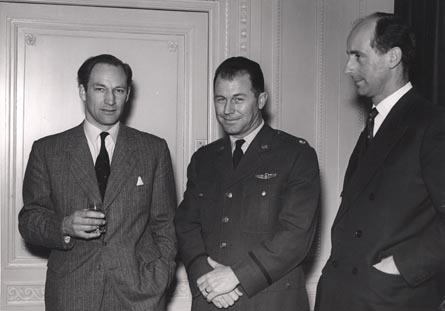Test pilots today are largely invisible to the general populace, but the 1950s saw perhaps the apogee of their public recognition.
One of the great periods of aeronautical innovation saw a seemingly endless stream of new designs taking to the air. For a while, national technological virility was measured in terms of ever-higher speeds, and the men who flew the latest designs were household names.
It was against this background that, on 10 March 1956, Peter Twiss made one of the largest jumps in the world speed record as he twice piloted the Fairey FD2 research aircraft along a measured 15km (9 mile) course along the south coast of Britain - at an average speed of 1,132mph (1,820kph). This not so much broke as vaporised the existing record of 822mph set just months earlier by US Air Force Col Horace Hanes in a North American F-100C Super Sabre.
 |
|---|
© Royal Aeronautical Society (National Aerospace Library)Left to right, Peter Twiss, then of Fairey Aviation, with Lt Col Charles E Yeager and Sqn Ldr Neville Duke, chief test pilot of Hawker Aircraft, at the Royal Aeronautical Society in 1956 |
The delta-winged Fairey FD2 set the record on a Saturday evening - the following day, journalists from every newspaper in London beat a path to Twiss's doorstep, and Monday morning saw him briefly become the most famous man in the country.
Just six months later, he again made the headlines when he was taking off in the FD2 to perform at the Farnborough air show. As he engaged reheat on the Rolls-Royce Avon on his take-off run, the aircraft's three braking parachutes accidentally deployed.
Twiss cut, then re-engaged reheat before taking off, jettisoning the parachutes and, together with fellow Fairey test pilot Gordon Slade in the other FD2, calmly proceeding with their scheduled low-level display.
Lionel Peter Twiss was born in Lindfield, West Sussex, on 23 July 1921. Ironically, given his later career, he was initially rejected as a pilot by the Fleet Air Arm. However, on the outbreak of war in 1939 he escaped from his role as an apprentice tea-taster, enlisted as a Naval Airman Second Class and trained to fly. His initial operational experience was on the Hawker Hurricane, in which he was assigned to merchant vessels equipped with a catapult. This arrangement was designed to provide convoys with a means of combating long-range German patrol aircraft but - with no means of landing back on the ship - a pilot had to end the sortie by heading for land or bailing out close to the convoy, and hope he was picked up by one of its ships - a decidedly risky enterprise.
He then moved to Fairey Fulmar fighters on board the elderly carrier HMS Argus on Mediterranean convoys, being awarded a Distinguished Service Cross. A Bar to the decoration came with his service on Supermarine Seafires during the Allied landings in North Africa, before he moved to another thoroughbred, the De Havilland Mosquito, on intruder sorties over occupied France.
In 1945 he attended the Empire Test Pilots School, before moving to Fairey, becoming chief test pilot in 1954. Designs he tested included the Firefly, Gannet and the highly-advanced Rotodyne compound helicopter.
When Fairey was bought by Westland in 1959, he chose to retire from test flying. He had decided against becoming an airline pilot. According to his widow Jane - Twiss was married five times - he felt it would be boring. Speaking to their local newspaper, the Portsmouth News, she said: "He said it would be like driving a bus."
Instead, Twiss joined Fairey Marine, where he was responsible for the development and sales of the company's day-cruisers, and developed a love of power boat racing. This resulted in him taking the unlikely role of a motorboat-steering SMERSH operative in the 1963 James Bond film From Russia With Love. Twiss died on 31 August, aged 90, in Titchfield, Hampshire.
- Peter Twiss, born 23 July 1921, died 31 August 2011
Source: Flight International













